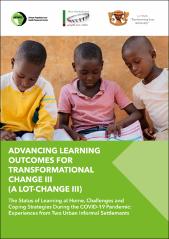| dc.description.abstract | At the onset of the COVID-19 pandemic, about 1.6 billion learners (94% globally) from pre-primary to higher education were
affected by the partial or total closure of schools (UN, 2020). As shown in Table 1, projections from UNESCO 2020 show that
23.8 million (10.9 million in primary and secondary school) children, adolescents and youth are at risk of dropping out of school
globally due to the COVID-19 pandemic. Of these, 11.2 million are girls and young women due to the increased risk of early
pregnancy and marriage, sexual exploitation and abuse, and female genital mutilation (UNESCO, 2020b). According to these
estimates, almost half (47%) of those at risk of not returning to school, come from South and West Asia (5.9 million) and sub-Saharan
Africa (5.3 million). Based on experiences from previous emergencies such as the Ebola crisis, adolescent girls are projected
to most likely face increased risks such as early and forced marriages, increased pregnancy and transactional sex due to poverty
(UNESCO, 2020a).
In addition to the UNESCO projections, the Malala Fund (2020) estimated that about 10 million girls in secondary education in
low and lower-middle income countries were at risk of dropping out because of the COVID-19 pandemic. The World Bank also
estimated that the out-of-school population would increase by 2% with approximately 7 million primary and secondary school
students globally facing the risk of dropping out (World Bank, 2020). Despite the different numbers, it is clear that the pandemic
will have an adverse effect on dropout rates. Unfortunately, these numbers will only add to the 258 million children of primary
and secondary school age who were already out of school prior to the pandemic (UNESCO, 2019a). In addition, there are worries
that the pandemic could result in a loss of between 0.3 and 0.9 years of schooling (Azevedo, Hasan, Goldemberg, Iqbal, &
Geven, 2020). | en_US |

